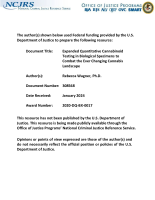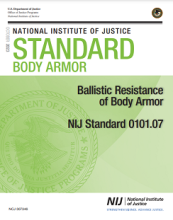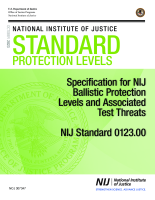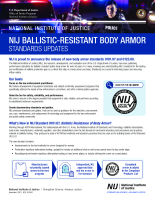Standards
Establishing Standards for Side-by-Side Radiographic Comparisons
Production and certification of NIST Standard Reference Material 2372 Human DNA Quantitation Standard
Improving Analysis of “Trace DNA” Evidence
Researchers try a new way to maximize DNA in low-yield situations and reduce costs.
We Did It! You can too! An Inside Perspective to Implementing Standards on the OSAC Registry
,
Updated Body Armor Standard Takes Aim at New Challenges
NIJ has released an updated body armor standard to keep up with evolving weapons, improve female officer safety.
Ballistic Resistance of Body Armor (NIJ Standard 0101.07)
Specification for NIJ Ballistic Protection Levels and Associated Test Threats (NIJ Standard 0123.00)
NIJ Ballistic-Resistance Body Armor Standards Updates
The development and pilot testing of a family treatment court best practices assessment: The model standards implementation scale
Improving Methods Using Machine Learning and Databases in Forensic Anthropology
,
Standards and Conformity Assessment for Criminal Justice Restraints
Restraints are critical pieces of equipment carried by law enforcement, corrections, and court officers. To help ensure that restraints meet minimal requirements, the National Institute of Justice published NIJ Standard 1001.00, Criminal Justice Restraints (pdf, 66 pages) in 2014 and Revision A in 2019 (pdf, 62 pages).[1]
Standard 1001.00 specifies the minimum requirements for form and fit, performance, testing, documentation, and labeling of...
Stab Resistance of Personal Body Armor, NIJ Standard-0115.00
The purpose of this standard is to establish minimum performance requirements and methods of test for the stab resistance of personal body armor intended to protect the torso against slash and stab threats. This standard is based on technical work performed by many organizations: in the United Kingdom by the Police Scientific Development Branch, and...
Ballistic Resistance of Body Armor, NIJ Standard 0101.07
NIJ’s planned online workshop for body armor manufacturers has been postponed from its original date of March 19, 2025. The webinar will provide updates on standards and conformity assessment activities related to ballistic-resistant body armor and include opportunities to ask questions. When a new date is determined, updated webinar information will be published here.
May 13, 2025...
Specification for NIJ Ballistic Protection Levels and Associated Test Threats, NIJ Standard 0123.00
NIJ has released two addenda to the standard. These addenda include revisions to NIJ Standard 0123.00, Specification for NIJ Ballistic Protection Levels and Associated Test Threats. Users of NIJ Standard 0123.00 should incorporate the revisions in this addendum as a part of the NIJ Standard.
NIJ plans to continue close coordination with ballistics laboratories and other stakeholders during the implementation...
Transient Workforce in Forensic Pathology: Challenges, Rewards, and Best Practices
,
Pivoting Headspace Ethanol Analysis to Accommodate Modern Day Scenarios
New Age Therapeutics: Development and Validation of an Analytical Workflow for the Analysis of Psychedelics in Biological Matrices
Development of a Stable Matrix-Matched Standard for Molecular and Elemental Analysis of Hair in Forensic Toxicology
NIJ FY 2021 Invited to Apply - Operation of the Secretariat of SC 37 under JTC 1 of ISO/IEC
Secretariat for ISO/IEC JTC 1/SC 37, Biometrics
Criminal Justice Technology Testing and Evaluation Center
De-escalation Training: What Works, Implementation Lessons, and Taking It to Scale; Plenary at the 2023 NIJ Research Conference
Police use of force, while infrequently used, is a tremendous concern to public safety in the United States when officers employ it excessively or inappropriately, causing injury or death and eroding public trust in law enforcement. This plenary from the 2023 NIJ Research Conference describes the Integrating, Communications, Assessment, and Tactics (ICAT) de-escalation training program developed by the Police Executive Research Forum to guide officers in defusing critical incidents.
See the YouTube Terms of Service and Google Privacy Policy
Embodying Evidence to Action: Tracking the Impact of Three Key NIJ Research Investments
Summary of the Opening Plenary at the 2023 NIJ Research Conference






